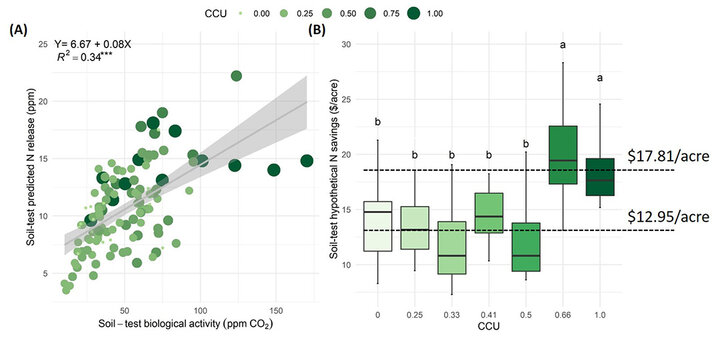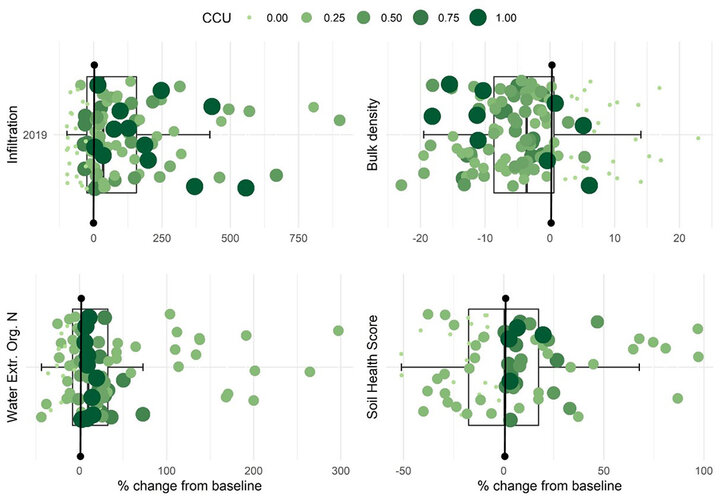Extending the presence of living vegetative cover to more months of the year through the use of cover crops has several environmental benefits — for example, prevention of soil erosion and nutrient leaching, improvement of soil microbial habitat and weed/pest suppression. But how much does including cover crops on farms improve physical, chemical and biological indicators of soil health? Our recently published work helps answer this common question, as a result of data generated by the USDA-NRCS Soil Health Initiative.
Nebraska Extension in collaboration with USDA Natural Resources Conservation Service (NRCS) employees collected soil samples at 10 on-farm fields comparing a range of soil health management practices. For each field-site treatment, we quantified the incremental changes in space and time, of soil health practices such as crop diversity, frequency of mechanical soil disturbance, cover crops, organic amendment use and crop-livestock integration as presented in Figure 1.

Soil samples were analyzed for indicators of soil health using the Haney Soil Health Test (HSHT), a commercial test that includes soil respiration and nutrient levels, and a locally developed NRCS assessment, a protocol that includes soil temperature, porosity, water infiltration, bulk density and soil moisture. Relative importance analyses were used to understand the extent to which incremental changes of each soil health practice drives predicted changes of 21 soil properties.
The use of cover crops was found to be the most impactful soil health practice, particularly on properties that are closely related to organic matter as well as carbon and nitrogen dynamics such as biological activity, organic matter, water-extractable organic carbon, nitrogen, total nitrogen and a soil health score. Averaged across all soil physical, chemical and biological properties, cover crop use had the most overall influence on the changes observed of all assessed soil properties, followed by years without soil disturbance, crop-livestock integration, organic amendment uses and crop diversity.
The relationship between soil test for biological activity and predicted nitrogen release is presented in Figure 2A. Soil-test predicted nitrogen release is a credit from the HSHT. It is calculated based on additional pools of nutrients beyond conventional fertility tests, which typically account only for inorganic nitrate and ammonium. Higher nitrogen release values are indicative of a greater amount of nitrogen being released through microbial activity from the organic nitrogen pools. The results presented in Figure 2A show that the greater the number of years with continuous living roots via cover crop adoption, the greater the values of soil-test biological activity and soil-test predicted nitrogen release. If organic nitrogen pools are considered in nitrogen fertilizer recommendations as a way to capture a greater potential nutrient pool than standard soil testing, Figure 2B shows that fields with cover crops grown for eight years or more (cover crop use ≥0.75) could save nitrogen application costs of approximately $5.00/acre compared to less use of cover crops.

The data from the 2016-2017 baseline (the year the program was launched) and 2019 (two to three years after the on-farm treatments were established) is presented in Figure 3. Averaged across all fields, changes in infiltration, bulk density, water-extractable organic nitrogen and the soil health score were not different from zero (all these boxes presented in Figure 3 cross the 0% change from baseline). However, in field sites with no history of cover crop use (CCU=0), we observed trends of increased bulk density and reduced infiltration rates, water-extractable organic nitrogen, and soil health score compared to the initial assessment. Figure 3 shows that reducing fallow periods with long-term cover cropping showed improving trends in soil structure, water and nutrient cycling, and the overall soil health score.

The results from this study are informative from a scientific perspective as it offers greater potential for enhancement of farmers’ knowledge of the soil system and could be beneficial as an understanding of the implications of farm management decisions. For complete reported findings of this study, published results are available here:
Krupek, F. S., Redfearn, D., Eskridge, K. M., & Basche, A. (2022). Ecological intensification with soil health practices demonstrates positive impacts on multiple soil properties: A large-scale farmer-led experiment. Geoderma, 409, [115594]. https://doi.org/10.1016/j.geoderma.2021.115594
Acknowledgments
The authors would like to thank the Natural Resources Conservation Service (USDA-NRCS) and Robert B. Daugherty Water for Food Global Institute (DWFI) for funding support.
